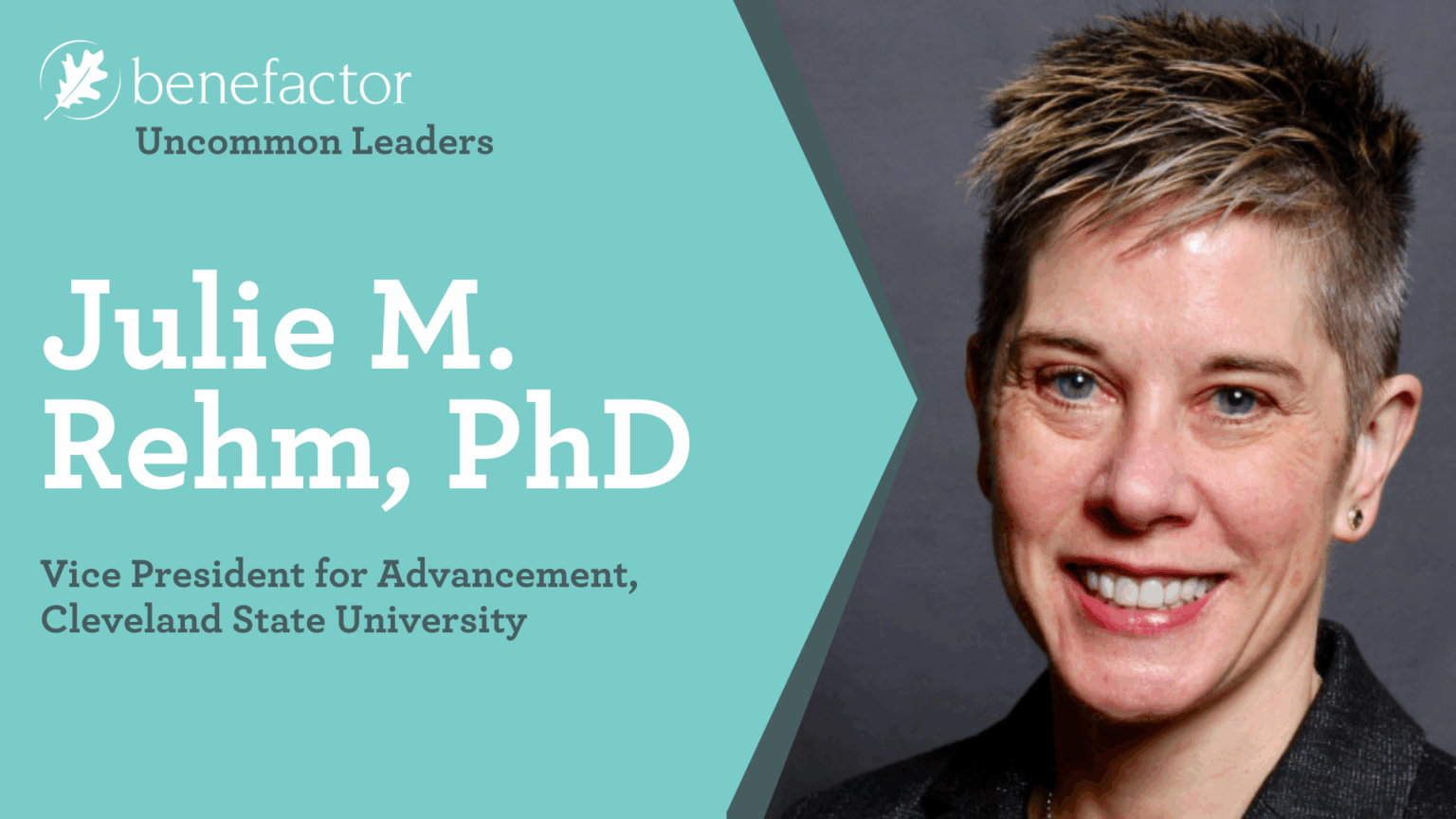Megan Simmons
Senior Consultant
Good leadership is easy to spot but hard to define. Popular idioms refer to leadership as influence, hope, or the ability to translate vision into reality. Some leaders are characterized by charisma, others by quiet acts of service. Debate continues over their origin: born, made, or something in between?
Benefactor Group is proud to work with leaders of all styles and backgrounds. Through this interview series, we have asked several of our partners, past and present, to share their personal leadership philosophies and career journeys. We found each conversation illuminating, and we have shared their varied accomplishments and lessons learned below.
About Julie M. Rehm, PhD
Dr. Julie Rehm serves as Vice President for Advancement for Cleveland State University, and Executive Director of the CSU Foundation. In this role, she leads fundraising and donor engagement efforts for a best-in-class urban research university and the dominant opportunity engine in Greater Cleveland—a university with alumni who account for more than $2.5 billion in economic activity across the region each year.
Specializing in public-private partnerships, Julie has spent her career building strong government, community, and donor relationships, particularly at major research and health institutions. Previously, at Case Western Reserve University, Julie served as a senior development leader for a $1.8 billion capital campaign and helped secure tens of millions of dollars in public sector funds. Earlier in her career, she held senior positions with the Cleveland Clinic and the Battelle Memorial Institute.
Committed to her community, Julie volunteers for many causes across Cleveland—from organizations seeking to create living wages, to those revitalizing Cleveland’s neighborhoods, to those providing social services and youth education. A scientist by training, Julie holds a PhD in Chemistry from the University of Rochester.
It was a privilege to work with Julie and her team to develop a strong case for support for Cleveland State’s ambitious vision for biomedical science and discovery. Now, as Julie looks ahead to retirement at the end of the year (and her next chapter—as she calls it, “Julie 2.0”!), we invited her to share learnings from a career defined by advocacy, collaboration, and deep relationship building.
Q&A
Let’s start at the beginning. Did you always know you would be stepping into the world of higher education or advancement?
No, not at all. I have a very non-traditional education and career path. I fell in love with math and chemistry in college, which led me to a PhD. But I quickly realized the lab wasn’t where I wanted to be. I’m an extrovert—I like to advocate, to connect—so I moved into government relations, speaking with elected officials about the importance of science. Ultimately, that work is all about building trust, relationships, and connections…much like fundraising.
So, I began leaning more into fundraising, next at Case Western: a university with a well-known, expert medical school that allowed me to stay close to research and science without being in the lab. Ultimately, I came to Cleveland State. I was really drawn by Cleveland State’s mission of serving first-generation, non-traditional, and working students. That resonated deeply with my own experience.
I never planned this path, but mentors and opportunities along the way guided me here. And I’ve just found that I love being on a college campus. There’s this influx of new people and new ideas that is really energizing.
Is there a mentor who most shaped your leadership skills?
I’ve had many. I worked at Eastman Kodak after attending community college, and I had a mentor there who opened my eyes: to the power of science, and to the world beyond my hometown. Realizing all that was out there—all that was possible—gave me the confidence to pursue my master’s degree, and eventually a PhD.
When I first came to Cleveland, another mentor trusted me with major projects right away—even multi-million-dollar federal grants—which allowed me to quickly learn by doing, and to dive into the nuances of really complex topics. He really believed in me: he put me in different roles; each time, I learned and stretched new muscles. I’ve been incredibly fortunate to have mentors who believed in me and opened doors along the way.
What is your leadership philosophy?
Above all, passion and enthusiasm for the place and the people. It’s important to be excited about the mission, and to believe in the people who surround you. I try to be visible and accessible when I’m at work: a cheerleader for the institution externally, and for my team internally.
What accomplishments are you most proud of during your time at Cleveland State?
Without a doubt, my proudest accomplishment is the culture we’ve built in advancement at Cleveland State. I knew our culture was special when we experienced—as I very lovingly call it—the “burnt popcorn incident.” A new hire and young recent graduate of Cleveland State had just joined our team. She immediately felt so comfortable in the environment we had built that she brought popcorn to pop in the microwave. Of course, the popcorn burned, and the entire office took on that distinctive burnt-popcorn-smell! To me, that moment was a proud one. It demonstrated we’ve created an environment where people feel at home, or surrounded by friends. A place you feel like popping popcorn.
How do you build that culture of comfort and authenticity?
It’s the people that we hire. Chemistry with the team matters. We look for people who have the skills—but even more importantly, people who are collaborative, ready to roll up their sleeves, and not easily intimidated by the work. Even if someone’s a rockstar, they might not be the right fit for the team. I really do feel the group matters most—you want a group of people who show up, who go to lunch together, who share stories, who collaborate and kibitz—rather than a group where folks are sowing discontent. I’d say we all do everything in our power to keep the office positive, supportive, and fun.
What makes someone successful in the role of fundraising?
It’s all about their ability to build relationships across multiple dimensions. To do that, you need to be genuinely curious—to ask questions, and to really seek to understand what matters to the person you’re meeting with. A successful fundraiser is a nice, genuine, person who authentically cares about others—and a strategic thinker who can sift through a potential donor’s passions and interests to find a meaningful connection with Cleveland State. The intersection of these characteristics is key for a superstar fundraiser.
What advice would you give to someone who is entering the field of advancement?
Continue to be curious. Continue to want to learn—whether it’s about the people in your portfolio, the institution you represent, or the cause you’re working to advance. To me, that connects to being passionate. If you’re not passionate, switch it up. If you’re bored, there’s no need to overstay. Network. Be creative. Don’t be afraid to market yourself in different ways. That’s how I ultimately made the transition from scientist to fundraiser!
What are you most excited about as you look forward to your next chapter?
I really feel I have more to give. This year, we went on a cruise to Antarctica. It was life changing. As we approached the shore, I remember looking out at this vast landscape. It was very emotional. It reminded me how small we are, how big the world is, and how much more I want to do.
Leadership Takeaways
Julie’s collaborative, relationship-focused approach to leadership has long inspired me. During our conversation, she shared a few phrases that reflect these core elements of her style and—in my opinion—model the kind of leadership we should all aspire to:
- “I try to be a cheerleader for the institution and the team.” Throughout our conversation, Julie stressed the importance of genuine excitement for the mission and the people who surround you, especially from leadership. A leader’s enthusiasm is contagious—it inspires confidence, sets the tone, and helps people see how their individual contributions advance a greater purpose.
- “You want a group of people who show up, who go to lunch together, who share stories.” Collaboration makes our work better. When we have the space to gather with colleagues in formal and informal ways, it can lead to brand-new ideas and outside-the-box thinking. This applies to more than just fundraising and philanthropy—when Julie and I were working together to advance biomedical science and discovery, we often talked about the power of “intellectual collisions” to inspire new breakthroughs.
- “You need to be genuinely curious.” The most meaningful philanthropic conversations begin by listening. I resonate with Julie’s approach to fundraising as an exercise in matching a donor’s greatest passions with an organization’s greatest opportunities for impact.
- “I have more to give.” I just loved this reflection as Julie prepares for her next chapter. It reminds me leadership doesn’t end with a role—it’s a way of being, rooted in generosity, curiosity, and a desire to lift others up.





